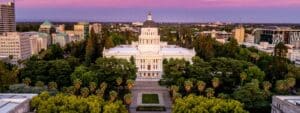John King
“Generation gap” is a phrase past its prime, like a guy who thinks he’s still hip because Levi’s are still his look.
But it rings true in the Bay Area of 2010, especially with regard to attitudes about the shape our cities and suburbs should take.
More and more, there’s a disconnect between the established view of how we should grow, and the values of people who weren’t even born when activists first battled “Manhattanization.” The (mostly) gray-haired guardians who radiate the certainty that They Know Best have dominated the debate for decades, but they can’t defy the calendar. With every passing year, the old certainties look a bit more … old.
Which brings us to Berkeley, where voters this month approved an advisory measure that would focus the city’s growth downtown.
Measure R hit all the buttons of 21st century urban environmentalism: The ballot question framed the issue at hand as “concentrating housing, jobs and cultural destinations near transit, shops and amenities” to “revitalize the downtown and help make Berkeley one of the greenest cities in the United States.”
The measure also would make room for three buildings of 180 feet – equal to office buildings of the same height from 1925 and 1969 – and opponents responded as though Sears Tower was being shipped to Shattuck Avenue. The ballot arguments warned of “empty promises with destructive proposals” and “a developer-backed plan … allowing outsized development to overwhelm surrounding neighborhoods.” Man the barricades!
It was vintage fight-the-power rhetoric. But this time around, Measure R captured 63.97 percent of the vote.
A big reason for the success, I’ll wager, is that the backers included the Sierra Club and Greenbelt Alliance, organizations with long track records and solid green reputations.
“The concept of environmentalism is maturing,” suggests Jeremy Madsen, Greenbelt Alliance’s executive director.
The group until 1987 was known as People for Open Space; from the start, it took the position that growth should be steered toward existing cities, rather than farmland and bare hills. Only in the past decade has the alliance taken assertive steps regarding what happens inside the greenbelt.
“We’ve gone from mostly saying ‘no’ to saying ‘yes – in the right places,’ ” Madsen says.
This shift rubs some old-school environmentalists the wrong way, Madsen admits. But as the Berkeley vote shows, it’s in sync with younger people who like the idea of filling “their” downtowns with people and life.
“The options aren’t the cul-de-sac or Manhattan,” Madsen suggests. “What you see in Berkeley is a bit of what we see happening all over the Bay Area. … People are saying there’s a different urban form they’d like to see come to fruition.”
I don’t want to oversell the transition now under way.
There always will be growth-wary neighbors, at times justifiably so. Some people in their 60s love towers; some people in their 20s loathe them. Nor do I buy the premise that every additional housing unit in San Francisco or Berkeley means one fewer home on distant farmland. Families don’t choose between a McMansion in Brentwood or a 20th-floor condo on Rincon Hill.
But here’s the difference: This generation of activists has moved beyond the simplistic mind-set that change is to be resisted. Its definition of urbanity doesn’t start with the notion that the essence of San Francisco as a place – how it should look, how tall it should rise – was defined once and for all in 1969 or 1984.
One veteran who accepts the shift is John Kriken, a longtime urban designer with the international firm Skidmore Owing & Merrill who also now teaches at UC Berkeley’s College of Environmental Design.
“Kids today have grown up with a much greater awareness of sustainability issues and the role that density plays in protecting land from indiscriminate use,” Kriken says. “They see the bigger buildings, and they’re not fearful of them.”
This doesn’t mean today’s younger activists are right and the ones of Kriken’s era were wrong. It’s that – news flash! – times change.
“For every generation that chooses the city, the beginning point is now,” Kriken says. “The ‘real San Francisco’ is today. They don’t carry the images in their head that I have in mine, or that my friends have in theirs. They don’t have the baggage of all the past battles.”
And you know what? That’s a good thing.
This article was originally published in the San Francisco Chronicle.




